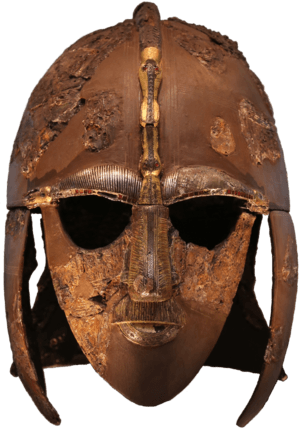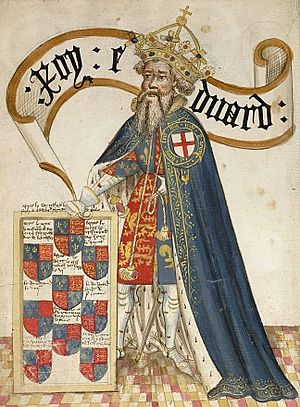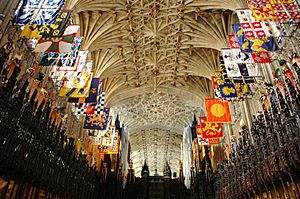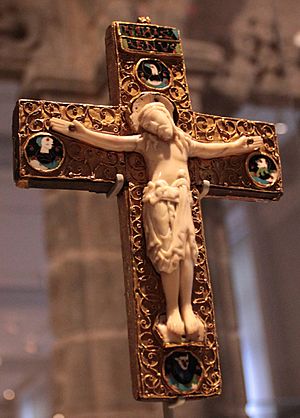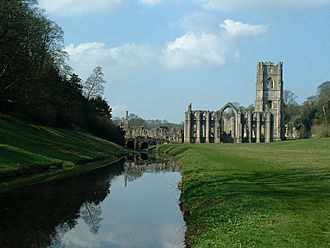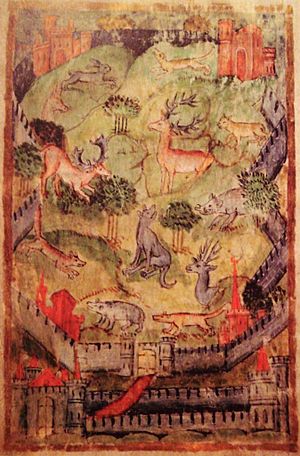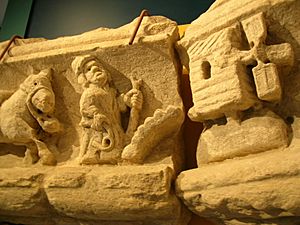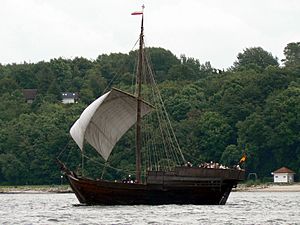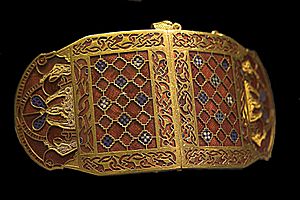England in the Middle Ages facts for kids

England in the Middle Ages is about the history of England during the medieval period. This time lasted from around 476 AD, when the Roman Empire fell, until 1485, when the Tudor dynasty began. When the Romans left, many English towns became empty, and the economy struggled. Germanic tribes moved into England, leading to power struggles.
Under the Anglo-Saxons, a rich artistic culture grew. They created amazing epic poems like Beowulf and detailed metalwork. The Anglo-Saxons became Christians in the 600s. Soon, many monasteries and convents were built across England. In the 700s and 800s, England faced fierce Viking attacks. These fights lasted for many years. Eventually, Wessex became the most powerful kingdom in England.
The Norman invasion in 1066 changed England forever. William the Conqueror and his followers took control. They used a network of castles to control the land and people. The new rulers used a system called feudalism. This ended slavery, but it created many unfree workers called serfs. The lives of women also changed as new laws about land were made. England's population grew a lot in the 1100s and 1200s. This led to more towns, cities, and trade. Warmer weather in Northern Europe helped this growth.
In the 1300s, the Great Famine and the Black Death hit England. These terrible events killed about half of England's people. They caused big problems for the economy and the way the country was ruled. People became angry, leading to the Peasants' Revolt in 1381. Many villages were left empty, and people moved to towns for new chances. New technologies appeared, and England had some great thinkers and scientists. English kings in the 1300s and 1400s claimed the French throne. This led to the Hundred Years' War. England had good times and bad times during this war. Later, the Wars of the Roses were civil wars fought between powerful English families over who should be king. Henry VII won in 1485. This marked the end of the Middle Ages in England and the start of the Early Modern period.
England's Political History
Early Middle Ages (500–1066)
At the start of the Middle Ages, England was part of Britannia. This was a former province of the Roman Empire. It already had towns, roads, and large homes called villas. After Rome fell in 476, Roman soldiers and rulers left. Then, Germanic immigrants started to arrive.
These new settlers built small farms and villages. Their language, Old English, quickly spread. More settlers came, and they soon outnumbered the people who had stayed. Powerful families ruled the Anglican culture in eastern England and the Saxon culture in the south. They set up kingdoms like Wessex, East Anglia, Essex, and Kent. They also started collecting tribute (payments) from nearby areas.
In the 600s, the kingdom of Mercia grew powerful. It took control of about 50 regions. Mercia and other kingdoms kept fighting for land in the 700s. Huge earthworks, like Offa's Dyke, were built to protect important borders. But in 789, the first Scandinavian raids on England began. These Viking attacks grew bigger and more frequent. In 865, the Danish Great Heathen Army invaded England. They captured York and defeated East Anglia. Mercia and Northumbria fell in 875 and 876. Alfred the Great of Wessex was even forced to hide in 878.
However, in the same year, Alfred defeated the Danes at the Battle of Edington. He used the fear of more Viking attacks to build a large army. Alfred kept the Danish invaders in a region called the Danelaw. Alfred's son, Edward the Elder, and his grandson, Æthelstan, conquered more land. York was finally taken back from the Vikings for good. The West Saxon rulers then became kings of all England.
Æthelred became king in 978 after his brother Edward was killed. England was then invaded by Sweyn Forkbeard, a Danish king's son, who took the throne in 1013. Sweyn's son, Cnut, took power in 1016. He even married Æthelred's wife. Æthelred's son, Edward the Confessor, had been in exile in Normandy. He returned to claim the throne in 1042. Edward had no children, so he had no one to take over after him. When Edward died in 1066, Harold Godwinson claimed the throne. He defeated a Norwegian who also wanted to be king, Harald Hardrada, at the Battle of Stamford Bridge.
High Middle Ages (1066–1272)
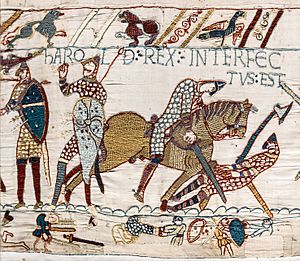
In 1066, William, the Duke of Normandy, saw a chance to take the English crown. He started the Norman Conquest. With an army of Norman followers and hired soldiers, he defeated Harold Godwinson at the Battle of Hastings. William quickly took control of southern England. He expanded his lands and gave them to his followers. By the time William died in 1087, England was the biggest part of an Anglo-Norman empire. This empire was ruled by nobles who owned land in England, Normandy, and Wales.
William II became king but faced rebellions. People tried to replace him with his older brother Robert or his cousin Stephen of Aumale. In 1100, William II died while hunting. His younger brother Henry I quickly took power. Wars broke out, and there were arguments about who should be the next king. Henry's daughter, Empress Matilda, had a son named Henry II. He signed a peace deal and became king in 1154.
Henry II's son, Richard, became king in 1189. Richard spent his time protecting his lands in France and fighting in the Third Crusade. His brother, John, became king of England in 1199. But John lost Normandy and most of Aquitaine in France after wars with France. John fought many battles to get his land back. Wars were expensive, so he made his people pay high taxes. In 1215, he was forced to sign the Magna Carta. This document brought peace and made sure the king was not above the law. Henry III became king after King John died.
Late Middle Ages (1272–1485)
Henry III's son, Edward I, made the monarchy powerful again. He fixed important castles that were not being used. This helped him expand his lands. Edward fought against the Welsh and sent people to live in their territory. He also fought wars in Flanders and Aquitaine. Edward wanted to rule Scotland too, so he fought battles in Scotland. He died before defeating Scotland. His son, Edward II, inherited the war with Scotland. Edward II was a weak ruler. He was overthrown by his French wife, Isabella, and a rebel noble, Roger Mortimer. Isabella and Mortimer's rule lasted only a few years. Then, Isabella's son, Edward III, took power in 1330.
Like his grandfather Edward I, Edward III started to make the king's power strong again. But in the 1340s, the Black Death arrived in England. The deaths from this terrible disease, and the plagues that followed, affected England for many years. Meanwhile, Edward, pressured by France, tried to take the French throne. England kept trying to rule France and fought many battles. These battles became known as the Hundred Years' War. Even though the war was expensive, Edward's battles brought wealth to England. Many English nobles, including Edward's son the Black Prince, were heavily involved in fighting in France.
Edward's grandson, the young Richard II, faced a rebellion of the people. This was called the Peasants' Revolt. It broke out across southern England in 1381. More rulers came and went during the Hundred Years' War. After Richard II died, Henry of Bolingbroke (Henry IV) took the throne. His son, Henry V, had success in battles and died in 1422. Henry VI became king when he was only nine months old. Both the English government and the war in France started to fall apart. Henry ruled for many years. But in 1453, Henry VI became mentally ill and could not run the country. A powerful nobleman, Richard, Duke of York, convinced other nobles to make him "Lord Protector." This meant he would run the country until the king got better. The king recovered in 1455 and wanted to rule, but Richard of York also wanted power.
A series of bloody civil wars, later called the Wars of the Roses, began in 1455. Two powerful families, Lancaster and York, fought over who would rule England. Henry VII of the House of Lancaster defeated Richard III of the House of York. Henry VII said he was bringing the two families together. To show this, he married Edward IV's daughter, Elizabeth of York.
Government and Society in Medieval England
How England was Governed and Social Classes
Early Middle Ages (600–1066)
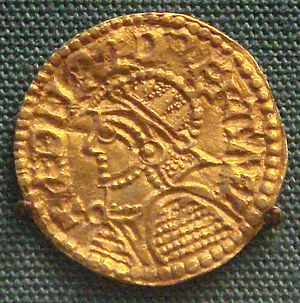
During the early Middle Ages, Anglo-Saxon kingdoms had a clear social order:
- King: The king was the top ruler. He was above many normal rules. His family and home had special protection. At first, kings were chosen, but soon the oldest son of the ruler took the throne. Kings became Christian, which linked religious practices to their rule. Churches were built, and the king saw himself as "Christ's deputy." The king also controlled the mints to make sure good money was made.
- Nobles (thegns or ealdormen): These nobles owned land and had their own courts. They were also in charge of defending and taxing the people. Because they owned so much land, they eventually had more power together than the king alone. Their title later changed to "Earl."
- Freemen (churls): Freemen owned land and ran businesses in towns.
- Peasants (geburs): Peasants worked on the land that belonged to the nobles.
- Slaves: Slaves could be bought and sold. They had very few rights.
High Middle Ages (1066–1272)
- Further information: Social history of England#Late medieval society
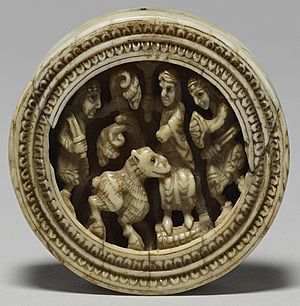
Walters Art Museum, Baltimore.
After the Norman conquest, about 8,000 Normans and French people settled in England. They kept the social order much the same. But other things changed. The new rulers built a system of loyalty using the feudal system. More powerful people promised land to less powerful people. In return, they got military support. Slavery decreased, but serfdom took its place. Peasants became villeins, or serfs. They were not allowed to leave the land where they worked or find other jobs.
Kings chose clergy (church leaders) to be chancellors. These chancellors were in charge of the country's money. The king had his own military group, the "familia regis." They were bodyguards and military staff. By the 1180s, the basis for English common law was mostly set up. Judges traveled around the country to deliver justice.
Kings gained more and more power during this time. Many believed that land should be passed down to sons, not given by the king. Norman nobles married Anglo-Saxon families, which caused arguments within families. The signing of the Magna Carta in 1215 limited the king's power. An early version of Parliament met for the first time in 1265.
Late Middle Ages (1272–1485)
Edward I made the king's power strong again and raised taxes. After Edward II became king, the balance of power broke down. Civil wars started in the 1320s. Edward III brought back order and organized the government. He used Parliament more than earlier rulers. To get support, he held fancy events based on chivalry. The idea of chivalry continued to grow in the 1300s. This was seen in new knightly orders (like the Order of the Garter), big tournaments, and round table events.
Because of the Great Famine and the Black Death, there were fewer people. This meant fewer people to pay rent to landowners and fewer workers for employers. This caused problems for the economy. Wages had to go up because employers had to compete for workers. Laws were made to limit wages. Laws also tried to stop lower-class people from buying luxury goods. A poll tax was started in 1377. This tax spread the costs of the war in France to more people. This made many angry, and the Peasants' Revolt began. The rulers fought back, killing as many as 7,000 people. A new class of gentry (people who rented land for money) grew. The legal system also continued to develop.
By 1399, when Richard II was removed from power, the nobles had grown stronger. Henry IV was able to control them. But they controlled the country during the rule of Henry VI. By the 1430s and 1440s, the English government had big money problems. This led to a crisis in 1450 and a popular revolt led by Jack Cade. Law and order broke down. The king could not stop the fighting between nobles and their followers. The Wars of the Roses began. When Henry VII defeated Richard III, he married Edward IV's daughter. He hoped this would unite the fighting groups.
Women in Society

Even though medieval England was a patriarchal society (men held most power), women could be powerful.
- Queens could own land and help run the kingdom.
- Noblewomen were allowed to lead the defense of their homes and towns. This happened if their husbands were away or had died. They had money from their husbands and the power that came with it.
- Most women worked on the land as part of the agricultural community. They also worked as brewers, bakers, clothes makers, dairy farmers, or servants. Some free women could own property, but they were often forced to remarry.
Identity in Medieval England
The Germanic immigrants and the Roman-British people in England mixed. They were called Angles and Saxons. By the 800s, the term Angelcynn was used to mean a single English people. This helped unite them to fight the Danish invasions.
The Normans and French who arrived after the Norman conquest saw themselves as different from the English. However, in the 1100s, as English and Normans married, their cultures blended. French remained the language of the royal court and was taught in England.
During the 1100s and 1200s, the English started to think they were better than the Welsh, Scots, Irish, and Bretons. They saw themselves as civilized, rich, and truly Christian. They thought the Celtic fringe (Wales, Scotland, Ireland) was lazy, wild, and behind the times. Italian and Baltic traders were seen as outsiders. They were sometimes attacked when the economy was bad. Even within England, people had different identities. Each group felt they had a certain status and importance. People from certain parts of England and those with higher social status thought they were more important.
Jewish Community in England
The Jewish community was important in England for much of the Middle Ages. The first Jews came to England after the Norman invasion. William the Conqueror brought wealthy Jews from Normandy to live in London. The Jewish community became richer by offering banking services. This allowed the king to use their wealth. All major towns had Jewish centers, and even smaller towns had Jewish merchants who traveled.
However, towards the end of Henry II's rule, the king stopped borrowing money from the Jewish community. By the time King John came to power, he took money from them. Eventually, Edward I forced the Jews to leave England in 1290. Foreign merchants then took their place.
Religion in Medieval England
The Rise of Christianity
Christianity was the official religion of the Roman Empire. The first churches in England were built in the late 300s. Bishops and priests led these churches. Many existing pagan shrines were changed into Christian places of worship. At the end of the 400s, when the Roman Empire fell, Germanic immigrants brought their own polytheistic gods. These included Woden, Thunor, and Tiw. Even with new pagan beliefs in England, Christian communities still survived in western areas like Gloucestershire and Somerset.
The conversion of the Franks in Northern France helped Christianity grow in the late 500s and 600s. Pope Gregory I sent missionaries to convert King Æthelberht of Kent and his family. This started the process of converting Kent. Augustine became the first Archbishop of Canterbury. He began building new churches across the southeast, often reusing old pagan shrines. This new Christianity started to influence the Anglo-Saxon military. Kings saw it as their right to go to war against pagan nations.
The Viking invasions in the 700s and 800s brought paganism back to northeast England. They brought their gods (similar to the Germanic gods) like Odin, Thor, and Ullr. They also believed in a final, huge battle called Ragnarok. But the Norse settlers eventually became Christian. Later, the Norse people in mainland Scandinavia also started to convert to Christianity.
Religious Institutions
When much of England became Christian in the 500s and 600s, many local churches were built. Monasteries were formed and run by abbesses (nuns), monks, and married priests and their families. Large Cathedrals were also built.
The Norman conquest in 1066 changed how monasteries were used. Norman and French church leaders were put in charge. Monasteries became part of the feudal system. They had to provide military support to the king. The Normans adopted the Anglo-Saxon idea of monastic cathedrals. Within 70 years, most English cathedrals were controlled by monks. Every English cathedral was rebuilt by the new rulers. England's bishops remained powerful, owning castles across the country. By 1215, there were over 600 monastic communities in England. Knights became popular and fought for England's honor.
Church, State, and New Ideas
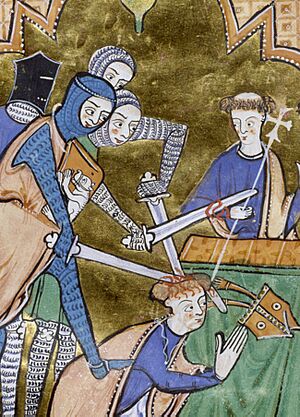
The church and the government were very close throughout the Middle Ages. Bishops and other church leaders were important members of the king's council.
William the Conqueror got the church's support for his invasion of England. He promised to change how the church was run. William encouraged clergymen to be unmarried and gave church courts more power. He also made the church more answerable to the king, rather than to Rome. Kings and religious leaders started to disagree about who had more power in the country.
John Wycliffe, an English philosopher and theologian from University of Oxford, challenged the idea that priests were the best guides to understanding God. He believed that scripture (the Bible) was the best guide. Religious leaders did not like to be challenged. They called Wycliffe's teachings heresy (beliefs against official church teachings).
Pilgrimages and Crusades
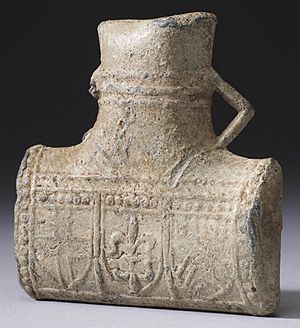
Pilgrimages were a popular religious practice in medieval England. This tradition went back to Roman times. Pilgrims usually traveled short distances to a shrine or church. They went to ask for forgiveness for sins or to seek help for an illness. Some pilgrims traveled further.
During the Anglo-Saxon period, many shrines were built on old pagan sites. Pilgrims visited these sites and monasteries. Important nobles or kings would travel to Rome. Collecting relics (holy objects) became important for pilgrimage sites. Relics were believed to have special powers. This made the site where they were located more important. By the 1100s, people reported that miracles were being performed by dead saints.
Taking part in the Crusades was also seen as a type of pilgrimage. England took a big part in the Second, Third, and Fifth Crusades. The idea of going on a pilgrimage to Jerusalem was not new in England.
Economy and Technology in Medieval England
Geography of England
England's geography was varied. It had the Fenlands of East Anglia and the heavily wooded Weald. It also had the upland moors of Yorkshire. Medieval England had two main zones, divided by the rivers Exe and Tees. The south and east of England had lighter, richer soils, which were better for farming. The north and west had poorer soils and a colder climate. So, people there mostly raised livestock. This is called pastoral farming. The land had more trees than it does today. Bears, beavers, and wolves lived wild in England. The road system built by the Romans and rivers were used for travel.
For much of the Middle Ages, England's climate was different from today. Between the 800s and 1200s, England had the Medieval Warm Period. This was a long time of warmer temperatures. For example, in the early 1200s, summers were warmer and drier. These warmer temperatures allowed grapevines to grow further north than usual. The Warm Period was followed by several centuries of much cooler temperatures, called the Little Ice Age. This cold period at the end of the Middle Ages greatly affected English farming and living conditions.
Even at the start of the Middle Ages, people had already shaped the English landscape over many centuries. People tried their best to care for the forests. Dykes were built to drain marshes. Parks for hunting animals were also made.
Economy and Population
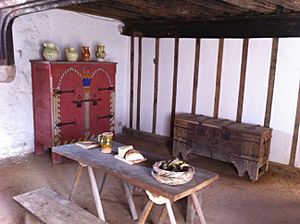
England's economy relied on growing crops like wheat, barley, and oats using an open field system. People also raised sheep, cattle, and pigs. In the late Anglo-Saxon period, many peasants gathered to form larger villages. They worked around a manor (a large estate). The landowner managed the land, while the peasants worked the fields. About 6,000 watermills were built to grind flour. This freed more peasants to work the land. By the 1000s, a market economy was spreading across England. Eastern and southern towns could trade with other countries.
For two centuries after the Norman invasion, the English economy grew. The population increased from about 1.5 million in 1086 to between 4 and 5 million in 1300. Forests had to be cut down to use the land for growing food. This was needed to feed the growing number of people. New towns were built, and trade increased. Guilds were created to support the growth in trade work. Mining increased in England. A silver boom in the 1100s helped to increase the money supply.
By the end of the 1200s, the population growth caught up with the economy. There simply wasn't enough land for everyone. The Great Famine caused a severe food shortage. The first outbreak of the Black Death in 1348 killed about half of England's population. Nearly 1,500 villages were deserted during this time.
The English cloth industry grew a lot at the start of the 1400s. International merchants also increased. Fishing in the North Sea moved into deeper waters, paid for by major merchants. Between 1440 and 1480, trade in England collapsed, causing prices to fall everywhere. By the end of the Middle Ages, the economy had started to recover. Improvements were being made in metalworking and shipbuilding.
Technology and Science
Technology and science in England advanced. This was helped by Greek and Islamic ideas that reached England from the 1100s onwards. Many advances were made in scientific ideas. These included the use of Arabic numerals and better ways to measure time. Clocks were first built in England in the late 1200s. The first mechanical clocks were put in cathedrals and abbeys by the 1320s. Astrology, magic, and palm reading were also seen as important knowledge. However, many people did not believe they worked.
Some important English scholars lived during the Middle Ages. Roger Bacon, a philosopher and Franciscan friar, wrote books on natural philosophy, astronomy, and alchemy. William of Ockham helped combine Latin, Greek, and Islamic writings into a general theory of logic. Johannes de Sacrobosco estimated the size of the earth in the 1200s. Gilbertus Anglicus published the Compendium Medicinae, one of the longest medical books ever written in Latin. The universities of Oxford and Cambridge were started in the 1000s and 1100s, following the example of the University of Paris.
Technological advances grew in many areas. Watermills to grind grain had existed during most of the Anglo-Saxon period. They used horizontal mill designs. These were replaced by a new vertical mill design. Windmills, water-powered fulling mills (for cloth), and powered hammers first appeared in the 1100s. The first blast furnace (for metal) opened in 1496. New mining methods were also developed. A new way to brew beer using hops came about in the 1300s. New ways to better preserve fish were invented. Stoneware replaced wooden pots, plates, and bowls by the 1400s. The printing press was used, and roads and docks were improved.
Warfare in Medieval England
Armies and Fighting Methods
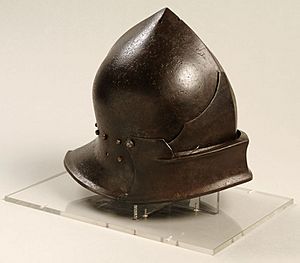
War was common in early Anglo-Saxon England. Groups of well-armed noblemen and their personal guards formed the main part of armies. They were supported by larger numbers of temporary troops from across the kingdom, called the fyrd. By the 800s, armies of 20,000 men could be called for battles. Another 28,000 men were available to guard city defenses. The most common weapon was the spear. Swords were used by wealthier nobles. Cavalry (soldiers on horseback) was less common. The Viking attacks brought new war tactics. These included using shield walls in battle and housecarls. Housecarls were elite soldiers whose job was to protect the king.
In Anglo-Norman warfare, commanders tried to raid enemy lands and capture castles to control territory. Armies were made up of mounted, armored knights. They were supported by infantry (foot soldiers). More men used the crossbow and shortbow in the 1100s. The size of armies changed under different kings. Hired soldiers (mercenaries) were also used, which made wars more expensive. Archers started using the longbow under Edward III. Cannons were first used by English forces at battles like Crécy in 1346.
Naval forces were important throughout the Middle Ages. The first mentions of an English navy are from 851. Historians described the ships of Wessex defeating a Viking fleet. English naval power became very important after losing Normandy in 1204. This made the English Channel a critical border, not just a friendly route. English fleets grew in size in the 900s. This showed the power of Wessex across the Irish Sea and the English Channel. In the 1200s and 1300s, fleets had special ships. These ships could fight near land or in open waters.
Fortifications and Defenses
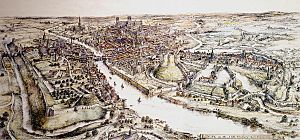
Many of the forts built by the Romans in England lasted into the Middle Ages. The Normans quickly started building wooden Motte-and-bailey castles. These helped them control their new lands. In the 1100s, they began building more castles out of stone. During the 1200s, defensive town walls were built across England. By the 1300s, castles were used for both defense and luxury. They had fancy living areas, landscaped gardens, and parks. Stylish castles in the late 1300s included gunports (openings for large guns or cannons) for defense. Because castles became more expensive to keep up, many were not maintained well. Some were even abandoned. During this time, tower houses were built in northern England to protect against any Scottish threat. By the late medieval period, town walls and grand gatehouses were a symbol of community pride, not just military defense.
Arts in Medieval England
Art and Design
Medieval England produced art in many forms. These included paintings, carvings, books, fabrics, and beautiful objects. Anglo-Saxon artists created carved ivories, illuminated manuscripts (decorated books), embroidered cloths, crosses, and stone sculptures. They made a wide range of metalwork. They often used gold and garnets for brooches, buckles, and sword hilts. Early designs used animals and geometric shapes. Naturalistic designs, showing people and nature, became popular from the 600s onwards.
The Norman conquest brought French artistic styles to England. This was especially true for illuminated manuscripts and wall paintings. Some Anglo-Saxon art forms remained popular even after the cultural change. The famous Bayeux Tapestry is an example of this. English tapestry-making and embroidery in the early 1300s were very high quality. Stained glass became a special form of English art during this later medieval period. However, the colored glass for these works was almost all brought in from Europe.
Literature, Drama, and Music
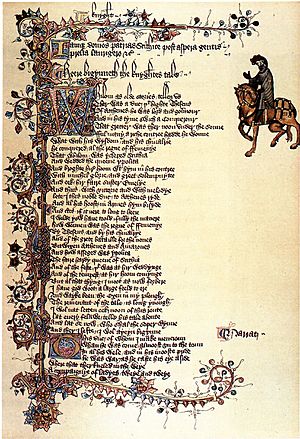
The Anglo-Saxons wrote a lot of poetry in Old English. Beowulf, probably written between 650 and 750, is a good example. It tells a vivid, heroic story, ending with the hero's death fighting a dragon. It also shows signs of the new Christian influences in England. Most of the poetry that still exists was written in the 900s and 1000s.
Poetry and stories written in French were popular after the Norman conquest. By the 1100s, some works about English history started to be written in French. Stories about the court of King Arthur became popular. Although English was used a little, most major works after the Norman conquest were written in Latin or French. However, the work of Geoffrey Chaucer from the 1370s onwards, ending with Canterbury Tales, was uniquely English in style.
Music and singing were important in England during the medieval period. They were used in religious ceremonies, court events, and plays. Singing techniques called "gymel" were introduced in England in the 1200s. Instruments like the guitar, harp, pipes, and organ were used. Carols became an important type of music in the 1400s. Ballads were also popular from the late 1300s onwards. These included the Ballad of Chevy Chase and others about Robin Hood. Miracle plays were performed to teach Bible stories in different places. By the late 1300s, these had grown into mystery plays, performed yearly over several days.
Architecture and Buildings
In the century after the Roman economy collapsed, many villas and towns were left empty. The Germanic immigrants built small rectangular buildings from wood and sometimes grander halls. When England became Christian in the 500s and 600s, masons built rectangular stone churches that were low to the ground. By the 900s and 1000s, much larger churches and monastery buildings were being built. They had square and circular towers, following the European style of the time. The palaces built for nobles focused on large timber halls. Manor houses also started to appear in the countryside.
The Normans brought their own architectural styles to England. They preferred simple stone churches. During the 1100s, the Anglo-Norman style became richer and more detailed. It included pointed arches from French architecture. This style is called Early English Gothic. It continued, with small changes, throughout the rest of the Middle Ages. In the early 1300s, the Perpendicular Gothic style was created in England. This style had tall sections with large windows. Fine wooden roofs, many in the hammerbeam style, were built in many English buildings. In the 1400s, the focus of architecture shifted from cathedrals and monasteries to local parish churches. These churches were often decorated with richly carved woodwork.
Meanwhile, the style of homes changed during the Middle Ages. The Normans built larger buildings from stone and wood. The style and size depended on how wealthy the owner was. Fashionable brick started to be used in some parts of the country, copying the French style. Not much is known about the houses of peasants during this period.
Legacy of Medieval England
How History is Written (Historiography)
The first history of medieval England was written by Bede in the 700s. Many more historical accounts followed, usually called chronicles. In the 1500s, the first academic histories began to be written. Edward Gibbon's writings in the 1700s were important. He saw the medieval period as a dark age between the great Roman Empire and the rebirth of civilization. Late Victorian historians continued to use the chronicles as sources. But they also used documents like the Domesday Book and the Magna Carta. They also found new financial, legal, and business records. They wrote about political and economic changes in England. By the 1900s, historians with new ideas started to challenge the history of medieval England. They used documents, archaeological finds, and scientific evidence.
Medieval England in Popular Culture
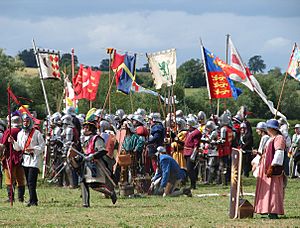
The Middle Ages in England have been used in many forms of popular culture. William Shakespeare's plays about the lives of medieval kings are still popular. Medieval mystery plays are still performed yearly in key English towns and cities. Filmmakers have made movies set in medieval England. Historical fiction set in England during the Middle Ages, especially detective stories, remains popular. J. R. R. Tolkien's stories of Middle-earth were inspired by this period. English medieval music was brought back in the 1950s. Medieval living history events first happened in the 1800s and early 1900s. Many people still meet regularly to do historical reenactments.
Interesting Facts About England in the Middle Ages
- Roger Bacon thought that the world would someday have automobiles and airplanes.
- Men thought long-toed shoes were very fashionable.
- During the Middle Ages, there were not many bridges in England.
- "Mob Football" was banned in 1314 because it was so dangerous and violent.
- Edward III made it a rule for all men to practice archery for two hours every Sunday.
- Farm animals in England were small during the Middle Ages.
- Some animals could be taken to court for crimes, like killing people or stealing crops.
- "Pygg" was a type of clay pot used for storing money. By the 1700s, they were known as "pig banks" or "piggy banks."
Images for kids
-
The Ellesmere illuminated manuscript of the Canterbury Tales by Geoffrey Chaucer, early 15th-century, showing the Knight


